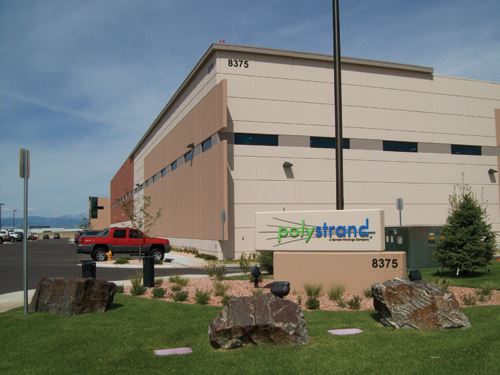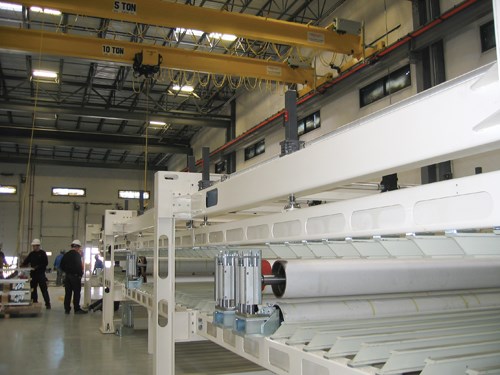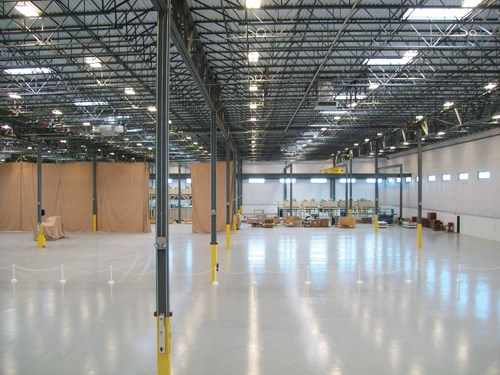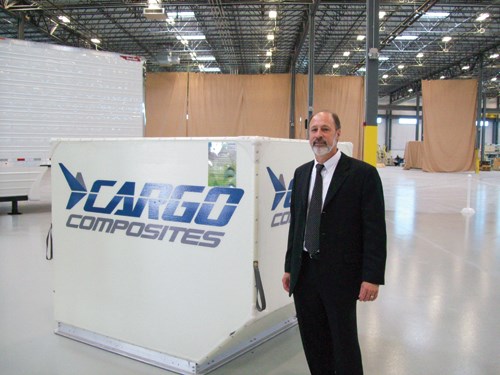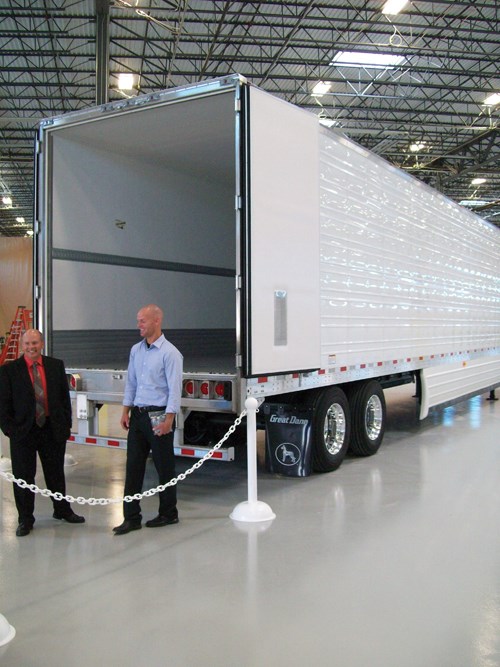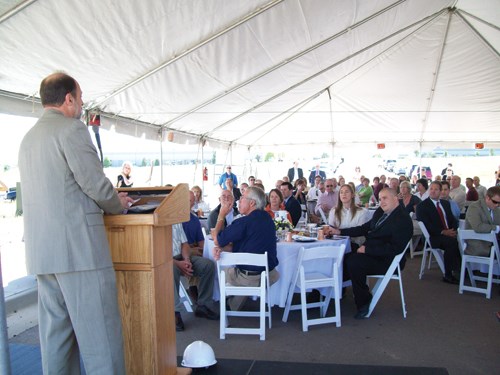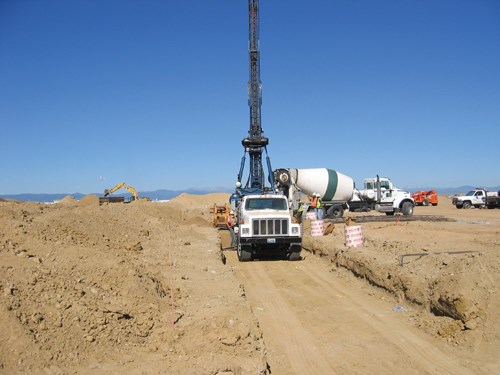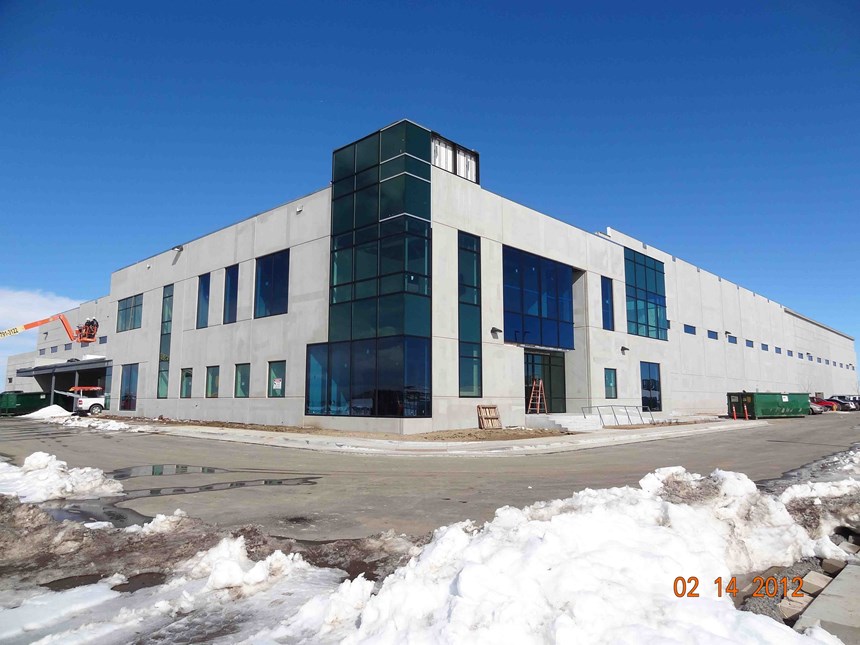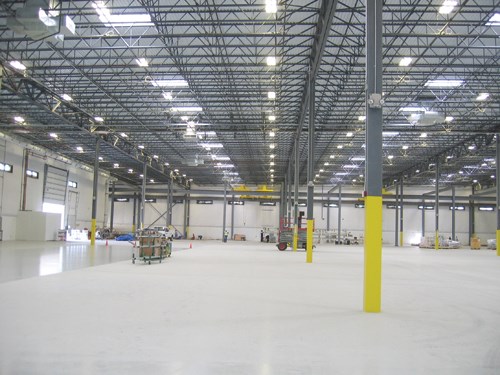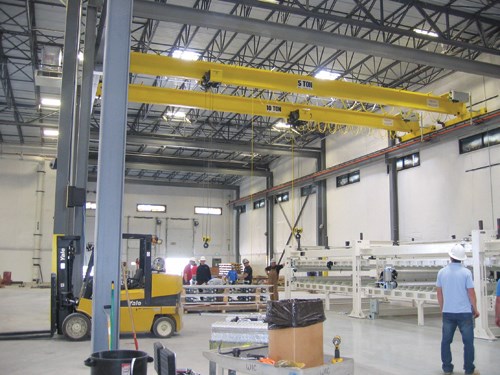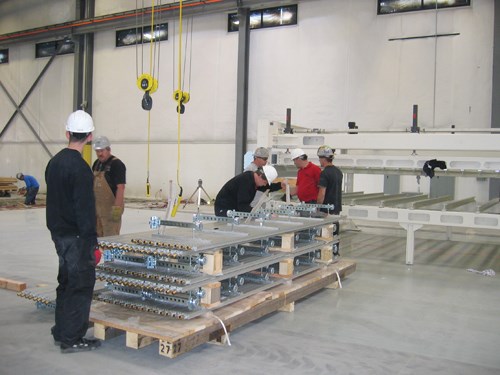Taking the gamble: Betting on material markets
Polystrand builds a new plant to produce market-leading quantities of thermoplastic composite material.
If, when and how should a manufacturer add production capacity in anticipation of a growing market? No doubt, many CT readers have had to grapple with this question. In the case of Gordon Holdings Inc. (Montrose, Colo.) and its wholly owned subsidiary Polystrand, however, expansion seemed like a natural next step for this low-key but successful business. “We never thought that the demand for Polystrand thermoplastics product would come as fast and as strong as it has, from automotive and trucking customers,” says Mike Gordon, the son of company cofounder Don Gordon and chairman of Gordon Holdings. The need was so great, in fact, that “we felt we had to expand beyond our current facility in western Colorado,” Gordon recalls.
What happened next would have been quite an accomplishment even if it hadn’t happened in the wake of the recent recession, when many retrenched businesses were still carefully lifting their heads to see if the coast was clear. Gordon Composites approached and gained the wholehearted support of local officials in Colorado’s Douglas County, Colorado politicians and local agencies, and secured financial backing from its bank. Then the company erected a massive new production facility and business office for its Polystrand division in a greenfield plot south of Denver, installed machinery, staffed up and started material production in just over one year. CT had the unique opportunity to document the process from groundbreaking to grand opening.
A serendipitous path
To understand the company’s decision to make a reported $25 million investment in a thermoplastic composites facility, one should start by understanding Gordon Holdings’ roots. Founder George Gordon, with a background in chemistry, started his career at Abbott Laboratories (Chicago, Ill.), where he was awarded some of the first patents involving thermoset composite laminates in the 1940s. Together with brothers Dave and Don, he created Gordon Plastics Inc. in 1953 and was instrumental in the development of very early fiberglass applications (some with epoxy matrices), including aircraft radomes. According to Ed Pilpel, Polystrand’s president and a collaborator with the Gordons since 1985, the brothers decided to brighten their first factory, a Quonset hut in San Diego, Calif., by cutting out sections of the corrugated metal roof and then using the cutout panels as tools on which they laid Owens Corning (Toledo, Ohio) glass mat wet out with polyester paint. The resulting translucent panels were reinstalled in the roof to let in natural light. Soon thereafter, a motorist drove by, saw the panels in the roof and stopped to ask if he could buy some. The brothers demurred until a price was named, and then those panels became one of Gordon’s first products. That led to a spinoff called the Alsynite Co. — and later, Gordon Skylight Co. — which made acrylic skylights. Although the skylight business was sold in 1985, the brothers had embarked on a number of other projects, including fiber-reinforced plastic car bodies and architectural elements, before sporting goods became their primary focus. Successful products in that market have included archery bows and laminates, snow skis, skateboards and diving boards. Notably, Gordon Plastics, the progenitor of Gordon Composites, was the first manufacturer to use composite elements in archery bows.
The company moved to Colorado in 1995 and, after a period of adapting their pulforming and compression molding processes to the higher altitude and drier air, the Gordons continued to produce their thermoset laminate technology for archery bow limbs.
Pilpel recalls that advanced thermoplastic composites caught his interest in the 1980s during the design and development phases of the U.S. military’s F-177A Night Hawk and F-22 fighter jets, which showed that thermoplastics could perform in high-performance applications. For Mike Gordon, an interest in thermoplastics developed under more mundane circumstances — what was supposed to be a simple project that involved making archery arrow shafts from thermoset composites. The customer’s rigorous requirements for straightness, however, led to a lot of scrapped shafts. Gordon realized that thermoplastic shafts could be reheated and straightened, if necessary, eliminating a lot of scrap. That led the two men to take a more in-depth look at the injection-molded thermoplastics market. Although the predominant material form was then, and continues to be, short-fiber-reinforced compounds in pellet form, their vision was a thermoplastic material that could take full advantage of continuous-fiber reinforcement to dramatically outperform short-fiber compounds, yet do so, if possible, at a competitive cost.
“We took a look at the continuous fiber-thermoplastic efforts that were gaining ground at that time, such as Twintex from Owens Corning and others,” says Mike Gordon. Using in-house expertise and refining the techniques that it believed worked best, the company ultimately developed its own proprietary hot-melt machine for making thermoplastic composite prepreg tapes at high speed, using any fiber and resin combination, in varying areal weights and layer combinations. The early polypropylene product prototypes “were competitive in price with Twintex,” remarks Gordon, at about $2.40/lb, but reportedly had 20 percent higher properties. Their prototype machine gave way to three large tape production lines, all of which will be moved from Montrose to the new Denver facility.
Part of the rationale for pursuing continuous fiber-reinforced thermoplastic uni tapes and laminates, explains Pilpel, is that the composite’s performance has improved compared to competitive materials. From a cost standpoint, “the price of polypropylene is significantly more today than in 1989,” he says. “So adding glass fiber as reinforcement isn’t as price-sensitive as it was when we started.” Ultimately, the decisive factor that led them to invest in the new plant was their passion for an environmentally sustainable product. They see Polystrand products, first introduced in 2005, as “next-generation” composites: fully recyclable; quickly postformable, free of volatile organic compound (VOC) emissions; and available in volumes great enough to meet the demands of new markets. “Those secret military programs 30 years ago opened the door for thermoplastic composites, and there is a huge market potential, but it takes decades for products like this to reach full commercialization,” adds Pilpel. “I’ve been working for 22 years to get to this plant.” The company’s philosophy was to take the plunge and build a facility that can produce 60 million lb/27,216 metric tonnes of laminate sheet per annum by 2015, and 100 million lb/45,360 metric tonnes by 2017, for transportation, industrial and, eventually, aerospace customers.
Finding the “green” spot
With that ambitious production goal in mind, Gordon and Pilpel faced the question of logistics. The Montrose facility was at capacity. Although a facility expansion was considered, they soon realized that the location — far from major air, rail and truck routes on Colorado’s Western Slope — would make shipping large quantities of product expensive and time-consuming. After looking at other U.S. locations, including Texas and as far away as North Carolina, they opted to stay in Colorado because, as Gordon says, “We like it here.” A thorough search of commercial real estate in the Denver metropolitan region turned up not one existing building that was both railway and highway accessible and large enough to accommodate the production equipment. That led to the decision to build a completely new plant — one that could accommodate the company’s headquarters operations and have plenty of room left over for future expansion. The company finally selected a 16-acre site at the Highfield Business Park. On former ranchland southeast of Denver and adjacent to Centennial Airport, the plot is only a few miles from Interstate 25. Says Gordon, “We decided it was a good location that supported our logistics.”
Gordon credits the key roles played by Highfield’s developer, Tom Bradbury, and a cooperative lender, Jim Friedberg at VectraBank Colorado, in bringing the financing, design and construction team together to fast-track the project. “We initially thought there wasn’t time or sufficient funding to build a new building,” Gordon recalls. “We certainly experienced some anxiety, but the team came through.” Friedberg says the bank was more than willing to underwrite the financing. “Polystrand and Gordon have a proven track record,” he explains. “We saw the product growth potential and liked the fact that Polystrand continually invests in its intellectual property.”
After groundbreaking on June 3, 2011, approximately 8.5 acres was cleared with earthmoving equipment, and a drill rig bored a series of 3-ft/0.92m diameter holes to accommodate 31-ft/9.45m deep reinforced concrete piers to support the building. With piers poured and a concrete footer in place, the concrete floor pad was poured. In mid-September 2011, the building’s tilt-up walls were raised: Formwork was placed on the floor pad that had been cleaned and prepared with a release product, and the forms were configured as needed to include window and door openings. With steel rebar placed within the forms, concrete was laid directly over the pad. A 150-ft/46m crane then lifted each of the cured wall segments off the pad into an upright position, and workers braced each segment and joined them together. Tucker Sims, Gordon Holdings’ onsite project manager, says an advantage of the tilt-up method is that all exterior wall electrical wiring was placed inside the forms prior to pouring the concrete, eliminating a building finishing step and streamlining the schedule. By November 2011, all walls were up and the 120,000-ft2/11,150m2 building was roofed.
As workers erected interior walls, installed plumbing and electrical services and finished offices, attention turned to the centerpiece of the 96,000-ft2/8,920m2 production area: the huge double-belt thermoplastic laminating press, manufactured by TechnoPartner Samtronic GmbH (TPS, Göppingen, Germany). Shipped to the building in 26 sea containers, the 50-ft/15.4m long, 8-ft/2.5m high and 12-ft/3.7m wide machine is the widest ever produced by TPS. It was accompanied by a crew of four German technicians who assembled its steel framework and internal systems, including the laminating belts, rolls, internal hot-oil heating system and material handling systems, over a period of four months. The laminator’s basic function is to orient, heat, compress and cool the continuous 25-inch/635-mm tape products and convert them to (typically) cross-ply, triple-ply or quad-ply laminates. In addition, the laminator press will be able to continuously laminate solid panels up to 0.35-inch/9-mm thick and cored sandwich panels up to 6-inches/150-mm thick, explains Pilpel. Any cross-ply tape or core material for multilayered products is fed from rollers located directly in front of the machine. The laminator is situated within the working envelope of three 10-ton overhead gantry cranes, with a total capacity of 30 tons, which are used to lift the thermoplastic composite tape rolls up into material feeders and lift finished product rolls from the opposite side of the machine onto trucks or into storage.
Drew Gordon, the plant manager, describes how a wide central lane running the length of the production area, which he has dubbed “Colorado Boulevard,” will allow ample access to the three thermoplastic composite tape machines (a fourth is under construction) and the TPS laminator, as well as to the first-in, first-out material storage area and ancillary operations like postproduction finishing. The tape machines and laminator will potentially work 24/7 to turn out Polystrand’s laminate products, continuously spooled up at the laminating machine’s end, in widths up to 10.7 ft/3,300 mm. Process scrap material will be ground into flakes and postprocessed into pellets for injection molding. To meet ever-growing customer demands for improved panel appearance, Polystrand’s engineering manager, Ben Pilpel, notes that the TPS machine has the flexibility to incorporate films, veils and other surface finishes that will enhance the cosmetics of the finished Polystrand laminates.
When asked if the gamble on a new plant and new customers is prudent given the economic uncertainties, Pilpel replies, “I see it as a gamble if we don’t do this. We’re jump-starting the commercialization of long-fiber thermoplastic composites with this facility — someone has to take the first step and make millions of pounds. And that’s us.”
Related Content
Update: THOR project for industrialized, recyclable thermoplastic composite tanks for hydrogen storage
A look into the tape/liner materials, LATW/recycling processes, design software and new equipment toward commercialization of Type 4.5 tanks.
Read MoreAssembling the Multifunctional Fuselage Demonstrator: The final welds
Building the all-thermoplastic composite fuselage demonstrator comes to an end with continuous ultrasonic welding of the RH longitudinal fuselage joint and resistance welding for coupling of the fuselage frames across the upper and lower halves.
Read MorePlant tour: Collins Aerospace, Riverside, Calif., U.S. and Almere, Netherlands
Composite Tier 1’s long history, acquisition of stamped parts pioneer Dutch Thermoplastic Components, advances roadmap for growth in thermoplastic composite parts.
Read MoreBraided thermoplastic composite H2 tanks with co-consolidated molded boss areas to fit EV battery space
BRYSON project demonstrates possible designs, automated manufacturing and low permeability concepts, including EVOH liner and novel PPA matrix.
Read MoreRead Next
Ultrasonic welding for in-space manufacturing of CFRTP
Agile Ultrasonics and NASA trial robotic-compatible carbon fiber-reinforced thermoplastic ultrasonic welding technology for space structures.
Read MoreScaling up, optimizing the flax fiber composite camper
Greenlander’s Sherpa RV cab, which is largely constructed from flax fiber/bio-epoxy sandwich panels, nears commercial production readiness and next-generation scale-up.
Read MoreCeramic matrix composites: Faster, cheaper, higher temperature
New players proliferate, increasing CMC materials and manufacturing capacity, novel processes and automation to meet demand for higher part volumes and performance.
Read More

